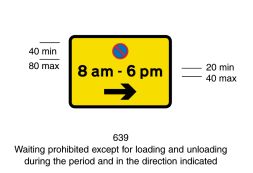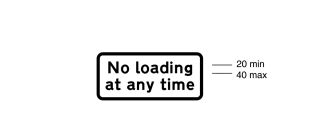|
The most common road markings you will come across are single and double yellow lines and thats where you will most likely receive parking tickets and penalty charge notices.
The appearance and measurements for yellow lines are governed by the Traffic Signs Regulations and General Directions 2002 (TSRGD 2002). In short single yellow lines mean that there is a waiting restriction (subject to exemptions) but is not 24/7.
Double yellow lines on the other hand mean (subject to exemptions) THAT THEY APPLY 24/7. It should be noted that a so called "no parking" sign does not exist in the legislation. The legislation refers to "waiting" so in general no parking means no waiting. In this page the term "no waiting" is used to mean the more commonly understood term "no parking".
So what should you be careful about to avoid a parking ticket or penalty charge notice?

SINGLE YELLOW LINES
You will find single yellow lines accompanied by , for example a sign indicating no waiting (e.g. Diagram 639 below). If the single yellow line is in a properly signed Controlled Parking Zone then sign 639 is not required.

The appearance and dimensions of a single yellow line are shown by diagram 1017 of TSRGD 2002 as shown above. You will note that the yellow line has a termination bar or T-Bar at right angles when it ends and that "permitted variants - none" is the designation shown below. To me that means the line is not valid without the T-Bar but parking adjudicators have said that if a T-Bar is missing it does not neccesarily invalidate the yellow line (see below for a more detailed discussion of the legal position)
The Legal Position of the Case of the Missing "T-Bar".
Often you will come across single (or double yellow lines) which have no "T-Bar", or termination bar where the yellow line ends. This T-Bar should be at 90 degrees to the yellow line as seen above.
These T-Bars are often missing when the yellow line abuts a parking bay or zebra crossing. So what is the law - is a such a yellow line with a missing T-Bar where it touches a parking bay or zebra crossing illegal? Does it matter if there is no T-Bar when a single line meets a double yellow line?
As can be seen from the table above item says quite clearly that there is no permitted variant of sign 1017 (the single yellow line).
You would think that the law is so clear and unambiguous that the yellow line in all these cases is illegal. Well in my view they are NOT legal.
HOWEVER YOU MUST BE PRACTICAL BECAUSE IF PARKING ADJUDICATORS ARE UPHOLDING THESE YELLOW LINES AS LEGAL THEN THERE IS NO POINT IN PARKING ON THESE SINGLE YELLOW LINES UNLESS YOU WANT TO TAKE THE CASE TO THE PARKING ADJUDICATOR AND IF YOU LOSE GO TO THE COSTS OF APPLYING TO THE HIGH COURT FOR A JUDICIAL REVIEW!
As an aside here is what The Department for Transport states clearly in its publication "Chapter 5 of the Traffic Signs Manual". It deals with yellow lines on page 116 paragraph 20.3 and states that there are 4 instances where the T-Bar must be used:
“A transverse mark must be placed at each end of a line, where one type of line changes to another, where it abuts a bay marking or a zig-zag line and at a point where a vertical sign indicates the time period changes, but the road marking remains the same."
However Parking Adjudicators have been ignoring the clear and unambiguous wording above and in the case of a missing T-Bar missing when the yellow line abuts a parking bay or zebra crossing they have been holding that it is valid!
The leading case decided by a Parking Adjudicator is the Minier Case
SO WHATEVER I THINK OR YOU THINK I RECOOMEND THAT YOU DO NOT PARK ON THESE SINGLE YELLOW LINES.
But compare this with the Gerrard T-Bar Case where I won a case representing the motorist. In this casethere was a missing T-Bar between a single and double yellow line.
In the Minier case the Adjudicator whilst accepting that the yellow line in question did not have the requisite T-Bar said that this was not important as "The law does not concern itself with trifles" and "it cannot possibly be said that Mr Minier or any other motorist would be misled or confused by the absence of T-bars". I have emphasised the word "and" because as I read the decision the adjudicator seems to take the view that both points must apply to overide the requirements of the legislation.
I believe that this decision is flawed but has been followed by at least one other adjudicator for whom I have great respect. An unfortunate Appeal Court case has added to the motorists burden as it implies that lines and signs must be substantial compliant.
But what about where one type of line changes to another? In a case where I represented the motorist ( Gerrard - v - Haringey case number to follow) the adjudicator held that where a single yellow line met a double yellow line and there was no T-Bar the relevant yellow lines were not enforceable.
MORE TO FOLLOW:
IMAGE TO COME IN HERE
If a single line has a waiting restriction (the use of the expression "no parking" does not exist in the legislation - in general no parking means no waiting) and is not in a Controlled Parking Zone a sign like sign 639 above must, according to the Department for Transports Traffic Signs Manual, be placed every sixtry metres alongs its length.
MORE TO FOLLOW:
DOUBLE YELLOW LINES (Diagram 1018.1 above)
These lines mean no waiting (except for exempted activity) 24 hours a day 7 days a week. They no longer need to be accompanied by a "no waiting at any time" sign (see below) although they often are.
As can be seen above
LOADING!!
You have all seen the dreaded " No Loading at any time" sign below. But under what circumstances is it enforceable and not enforceable? .

One important point to bear in mind is that signs showing loading restrictions (i.e no loading at "any time" or no loading for a lesser time period) MUST BE ACCOMPANIED BY KERB MARKING REFLECTING THE RESTRICTION!!!! A double kerb mark means " No Loading at Any Time" and must be acccompananied by the above sign. A single kerb mark means that there is a loading restriction but it is not 24 hours a day or not every day of the week. IT MUST BE ACCOMPANIED BY THE RELEVANT SIGN (see below where the sign which shows only a partial loading restriction will be accompanied by a single kerb mark)

 
So the fundamental rule is there must be both a sign AND kerb marks to indicate any loading restriction. One without the other means it is NOT enforceable.
What is the signi=ficance of traffic cones?
Traffic Cones are put out by councils and the police to indicated parking restrictions. The cones take two forms:
1. The normal red and white cones and
2. Yellow cones with the sign indicating no waiting at any time.
Whilst the latter cones are legaly enforceable the red cones in themselves are not but I do NOT recommend parking where it is clear that they indicate any sort of restriction!

To find out about Controlled Parking Zones click on this link.

|
Parking Bays: How to spot an invalid parking bay.
You should look to at the bay - if it is one long bay (i.e. not subdivided into individual bays) there should be a single terminating line at each end - if not it is invalid. Also there should be signs 5 meteres in from each end. If the bay is less than 30 metres long there should be a sign in the middle of the bay. If the bay is more than 30 metres long then there must be signs in the bay no more than 30 metres apart.
If the bay is a long bay subdivided into individual bays there should be a double terminating line at each end - if not it is invalid
|
|